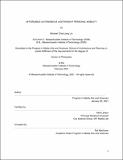Affordable autonomous lightweight personal mobility
Author(s)
Lin, Michael Chia-Liang.
Download1256658884-MIT.pdf (32.64Mb)
Other Contributors
Program in Media Arts and Sciences (Massachusetts Institute of Technology)
Advisor
Kent Larson.
Terms of use
Metadata
Show full item recordAbstract
Self-driving cars and micro-mobility services are among the most important trends in the mobility landscape. While robo-taxi services are still in the pilot phase, residents in many cities today are adopting micro-mobility services as a more affordable and energy-efficient last-mile alternative to traditional forms of transportation. This dissertation proposes a new genre of urban mobility by bringing together the advantages of micro-mobility with those of the self-driving car. This dissertation presents a novel vehicle design that leverages the safety and autonomous navigation capabilities of a self-driving car while remaining ecologically responsible, lightweight, and affordable. In addition, the novel design enables new types of urban mobility services with the ability to operate autonomously in bike lanes and low-speed urban environments, and to provide door-to-door mobility delivery of both people and goods. The proposed autonomous vehicle design takes a bottom-up approach, piecing together modularized hardware components and software blocks and giving rise to autonomous functionality. During the development of these systems, multiple full-scale working prototypes were completed, each designed to explore a specific research goal. The testing and evaluation of these prototypes were conducted within urban living labs, using the bike lanes of Cambridge, Taipei, and Andorra. Each prototype concluded with a public exhibition demonstrating the validity of these systems when applied to hypothetical mobility scenarios of the future. This dissertation includes the following five contributions: 1. A new genre of mobility that enables novel mobility services of the future. 2. A software framework for autonomous navigation that utilizes low-cost sensors and computers. 3. A set of human-machine interactions using state-of-the-art autonomous vehicle perception as input for establishing effective Vehicle-to-Pedestrian communications. 4. A new methodology for road tests and evaluation of these systems i n the living environment. 5. The introduction of a possible decentralized community-based mobility industry. This dissertation will describe the research story of successful cooperation across academic institutions, cities, industries, and borders.
Description
Thesis: Ph. D., Massachusetts Institute of Technology, School of Architecture and Planning, Program in Media Arts and Sciences, February, 2021 Cataloged from the official PDF of thesis. Includes bibliographical references (pages 302-308).
Date issued
2021Department
Program in Media Arts and Sciences (Massachusetts Institute of Technology)Publisher
Massachusetts Institute of Technology
Keywords
Program in Media Arts and Sciences